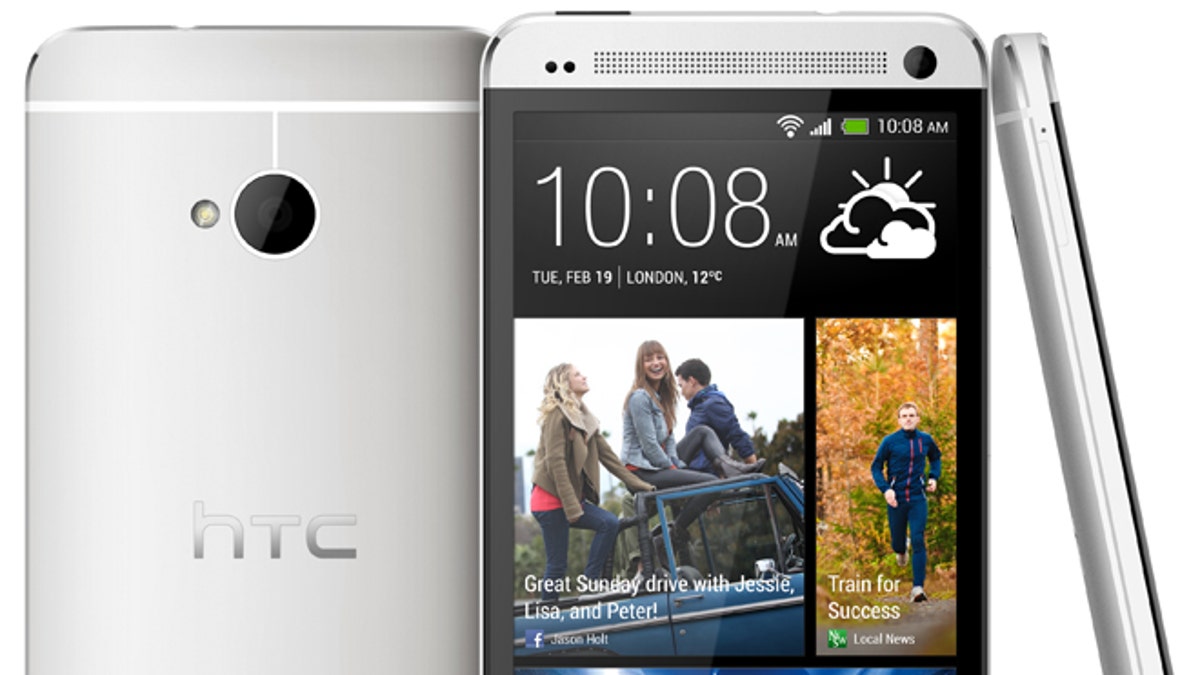
The HTC One, the flagship smartphone from the Asian technology powerhouse. (HTC Corp.)
NEW YORK – Ready for the battle of the phones? This year's crop of high-end smartphones is starting to emerge, like bear cubs crawling out of their burrows, sniffing the spring air. First out is the HTC One, a handsome, powerful animal that should do well this year.
The HTC One belongs to the big camp of smartphones running Google Inc.'s Android software. Collectively, they're the big alternative to the iPhone, though no one model outsells the iPhone. What makes the HTC One really stand out is that it's the only phone that can match Apple Inc.'s standards of feel and finish.
Much like the iPhone, the HTC One has a beautifully machined aluminum back and aluminum detailing on the front. Also like the iPhone, the metal edges are beveled, or "chamfered" as the industrial designers call it. Plastic and metal are joined together so well that you can't tell by feel where one ends and the other starts.
While the HTC One clearly borrows some elements of the iPhone 5's style, it's hard to mistake the HTC One for the iPhone. For starters, it is half an inch taller and broader, with a huge screen. It's also noticeably thicker at its maximum, but that's cunningly concealed by a bulging back and narrow edges. Bigger screens are one way Android phones take on the iPhone, and that inevitably leads to bigger phones, but the HTC One carries its bulk very well.
The screen is quite a sight, boasting a resolution of 1920 by 1080 pixels — as many as you'd find on a 50-inch TV set. You'd have to line up three iPhone 5s, side by side, to show as much detail as you can on one HTC One screen. That doesn't mean the screen is three times as useful. These pixels are just so small that the eye can't take advantage of the full resolution.
Above and below the screens are two speaker grilles. That means that when you turn the phone sideways to watch a movie, you'll get real stereo sound, without headphones. The speakers are great, too, pumping out surprisingly deep sound.
The price you pay for a body that feels as tight and sharp as a knife fresh from the forge is that nothing goes into or out of it. You can't change the battery, and you can't expand the memory with cards. Again, this is very much in the iPhone's vein, but it's a contrast to Samsung's Galaxy phones, which have chintzy plastic backs that allow you to change batteries and plug in memory cards.
The camera does something interesting, but the results are disappointing. It's well known that boosting the megapixel count of camera sensors doesn't really do much for the image quality, but phone and camera makers can't seem to stop using megapixel count as a marketing tool, so the megapixels keep climbing. HTC has finally taken a stand against this trend, with a camera sensor that has only 4 megapixels of resolution. It's a timid stand, though, as HTC doesn't actually tell you it's a 4-megapixel sensor.
Rather, HTC calls it an "Ultrapixel" camera. The story is that the sensor pixels are twice as big as they are in most phone cameras, which means they can gather more light. More light per pixel means better pictures in indoor lighting, at least in theory. In practice, I found the images to be better than those of other Android phones in low lighting, but not as good as those from the iPhone 5, which are of higher resolution. Low-light pictures taken on the HTC One do show relatively little "noise" — which usually looks like colored speckles — but the images aren't particularly crisp.
Another hardware feature that reaches but doesn't deliver is the infrared diode on the top edge. Through it, the phone can control your TV or cable box. But setting up the software is daunting. I was confronted with going through a list of 1,800-plus channels and manually selecting which ones I get from my cable provider. Even if I were to set this up, I still couldn't control the DVR functions of the cable box from the phone. So as a replacement for the remote, the HTC One falls short.
The phone's other big shortcoming isn't really new, or unique to this model. Rather, the problem is that HTC is doing what it's always done, and what competitors like Samsung do, too. It can't leave Android alone, but tinkers with it to "improve" it and put its own stamp on it.
The result is a baffling interface, with four different "home" screens from which to launch apps. It might reward those who take the time to customize it and really get to know it, but most people aren't like that. They're better served by simple, consistent interface. Google recognizes this and keeps Android relatively simple on its own Nexus line of phones. HTC and Samsung seem determined to make things complicated.
AT&T, Sprint Nextel and T-Mobile USA are set to start selling the phone this month. Prices will be about $200 with a two-year contract. There's no word yet from Verizon.
If you're looking for an Android phone, do yourself a favor and check out the HTC One in a store. Samsung Electronics Co. will outspend HTC Corp. many times over in marketing when Samsung's Galaxy S 4 comes out shortly. But if you take the time to feel the One in your hand, it will probably be your One.
___
Peter Svensson can be reached at http://twitter.com/petersvensson
